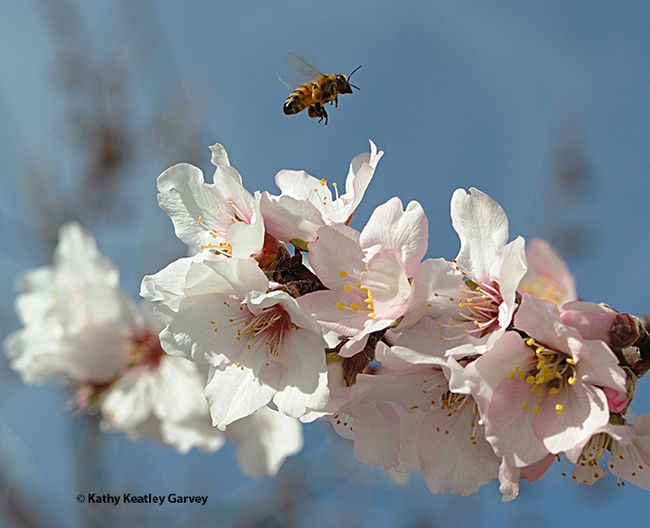- Author: Kathy Keatley Garvey
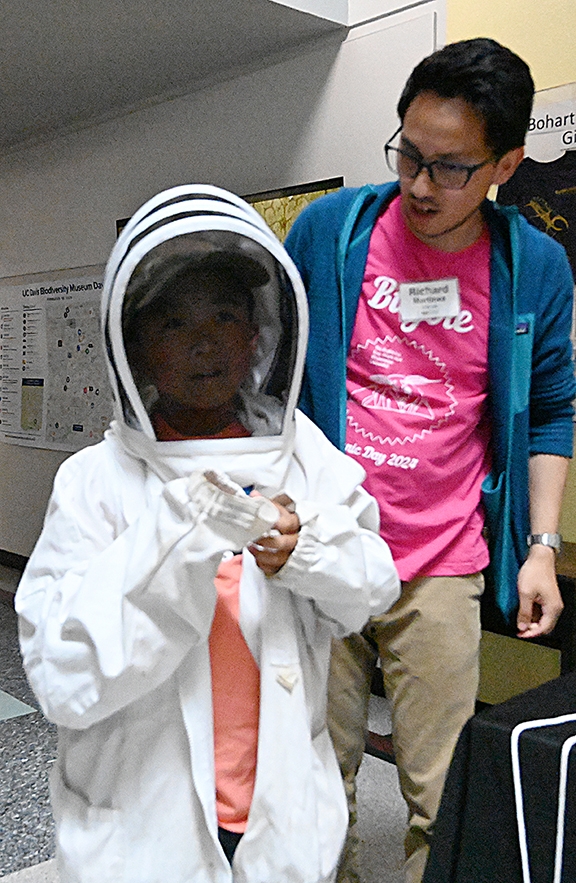
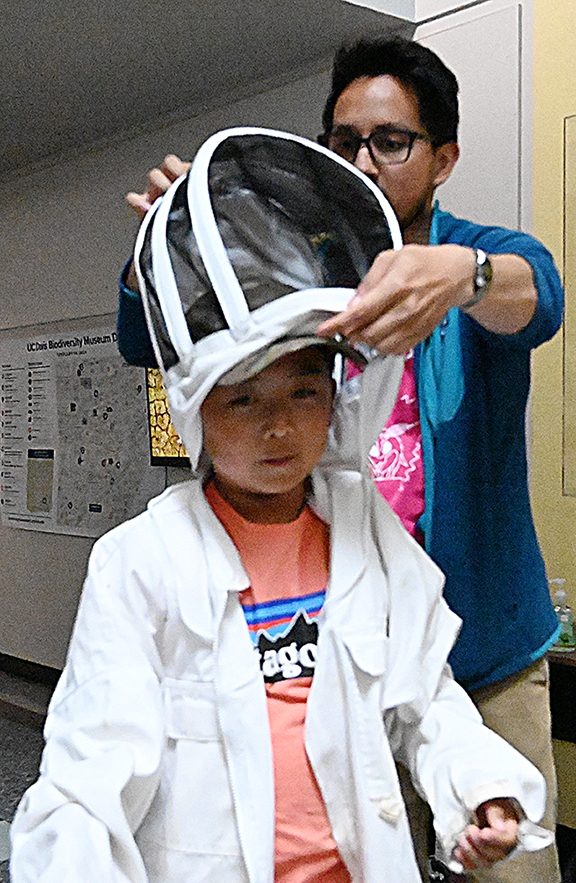
That was the consensus at the Bohart Museum of Entomology open house when attendees tried to locate the queen in the bee observation hive at a table staffed by UC Davis graduate student Richard Martinez of the Elina Lastro Niño lab, Department of Entomology and Nematology.
Martinez purposefully didn't mark the queen.
"Most kids thought the queen was going to be marked--common beekeeping practice--but mine wasn't, so they thought that was unfair," Martinez quipped. "Only one kid was able to find the queen. And it was toward the end of the event. The queen was laying an egg when we found her."
The drones, the males, also drew avid interest.
"After I mentioned the hive has drones, what i referred to as 'the boys'--it helps kids understand their role in the hive--they were fascinated with finding the drones, which they did."
Most kids, however, confused drones for the queen, Martinez said.
Attendees, both adults and youth, delighted in trying on the beekeeper veils and suits, and examining the hive tools and other apiary equipment.
"A lot of the kids asked what bees do inside the hive," Martinez said. "So I went through my list of roles honey bees carry out. One family was super invested in the science behind honey bee research, particularly nutrition, which is what I study."
"It was a pretty fun event," he said.
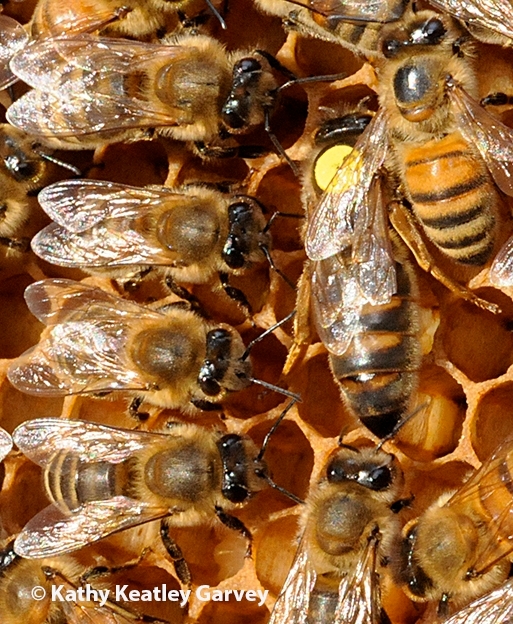
The queen bee, the largest bee in the colony, has a long, narrow, pointed abdomen, and shorter wings than the worker bee. The worker has a rounded abdomen and wings that extend almost to the end of the abdomen. The drone, stout in body, has what some call "wrap around eyes."
The Bohart Museum open house, held May 19 not only featured honey bees (managed bees) but wild bees. (More images pending)
Martinez, a master's student, studies honey bee health, specializing in nutrition, in the lab of E. L. Niño, associate professor of Cooperative Extension, and a member of the UC Davis Department of Entomology and Nematology faculty.
Martinez recently helped staffed the UC Davis Entomology Graduate Student Association (EGSA) t-shirt booth at Briggs Hall during the 110th annual UC Davis Picnic Day, where he and fellow graduate students wore "Bugbie" shirts. The t-shirt, designed by Marielle Hansel Friedman, a second-year doctoral student in the lab of urban landscape entomologist Emily Meineke, features a rosy maple moth, Dryocampa rubicunda. (EGSA offers a variety of t-shirts on its sales website at https://ucdavisentgrad.square.site/.)
The Bohart Museum, located in Room 1124 of the Academic Surge Building, 455 Crocker Lane, UC Davis, houses a global collection of eight million insects, plus a live petting zoo, and a gift shop. Professor Jason Bond, the Evert and Marion Schlinger Endowed Chair of the Department of Entomology and Nematology, and the associate dean, UC Davis College of Agricultural and Environmental Sciences, directs the museum. He also serves as president-elect of the American Arachnological Society.
The next open houses are set for
- Saturday, July 20: "Moth Night at the Museum," 7 p.m. to 11 p.m.
- Saturday, Sept. 28: "Museum ABCs: Arthropods Bohart, and Collecting," 1 to 4:30 p.m.
All open houses are free and family friendly; parking is also free on weekends.
Summer public walk-in hours are on Tuesdays, June 17-Aug. 27 from 9 a.m. to noon, and from 1 to 4 p.m. The museum will be closed to the general public from Sept. 1-22.
For more information, access the website at https://bohart.ucdavis.edu or contact bmuseum@ucdavis.edu.
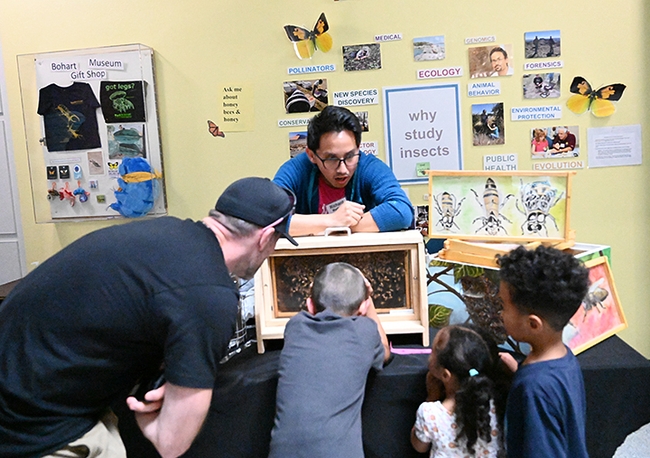
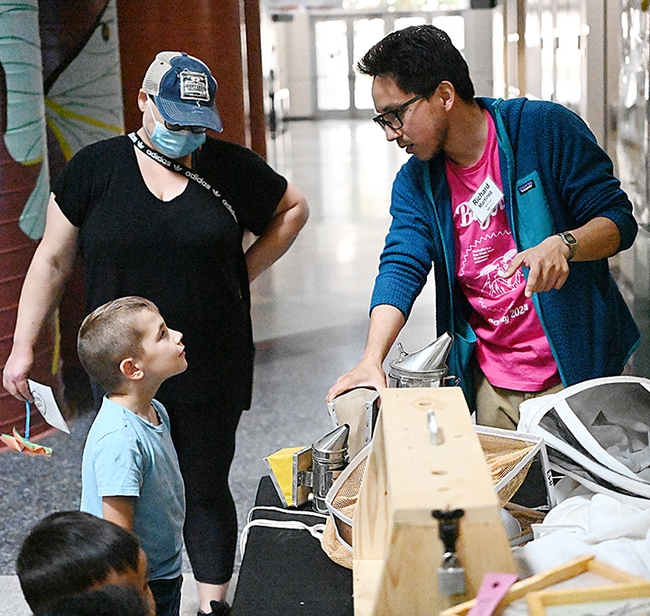
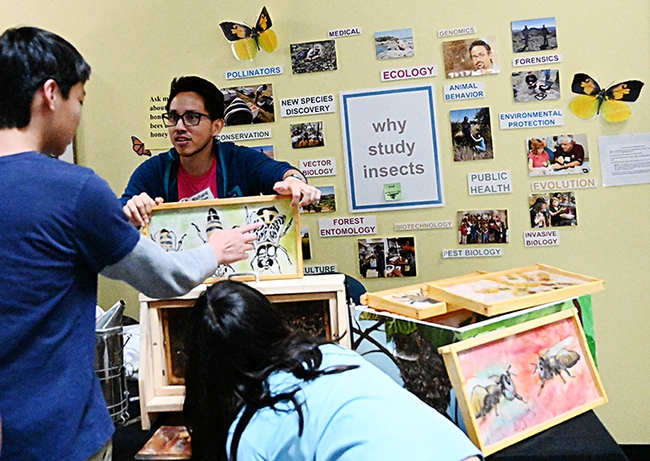
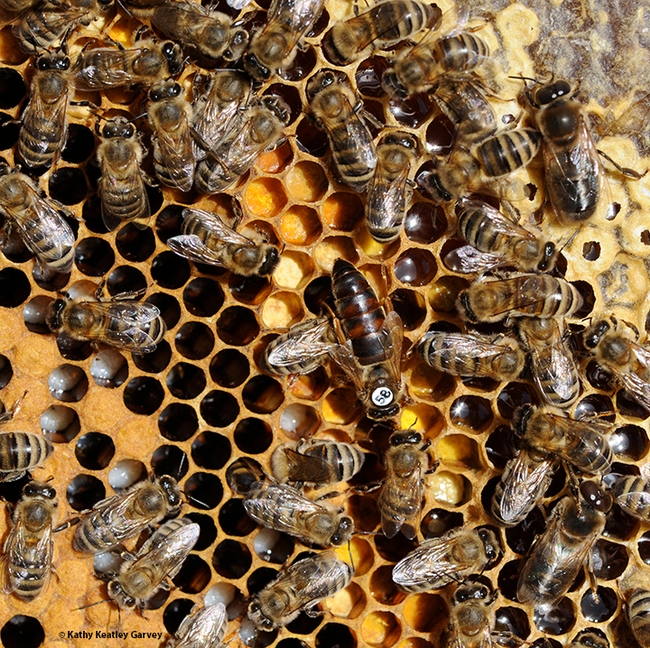
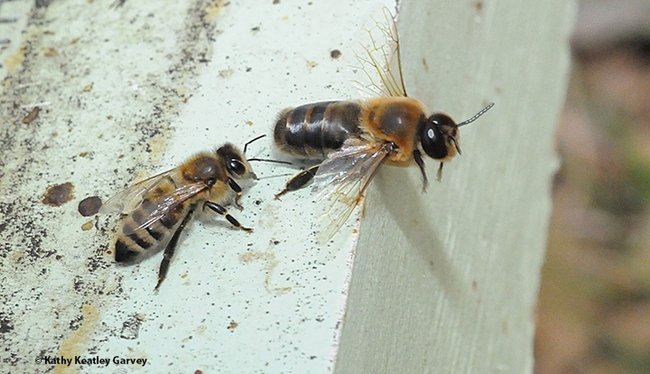
- Author: Kathy Keatley Garvey
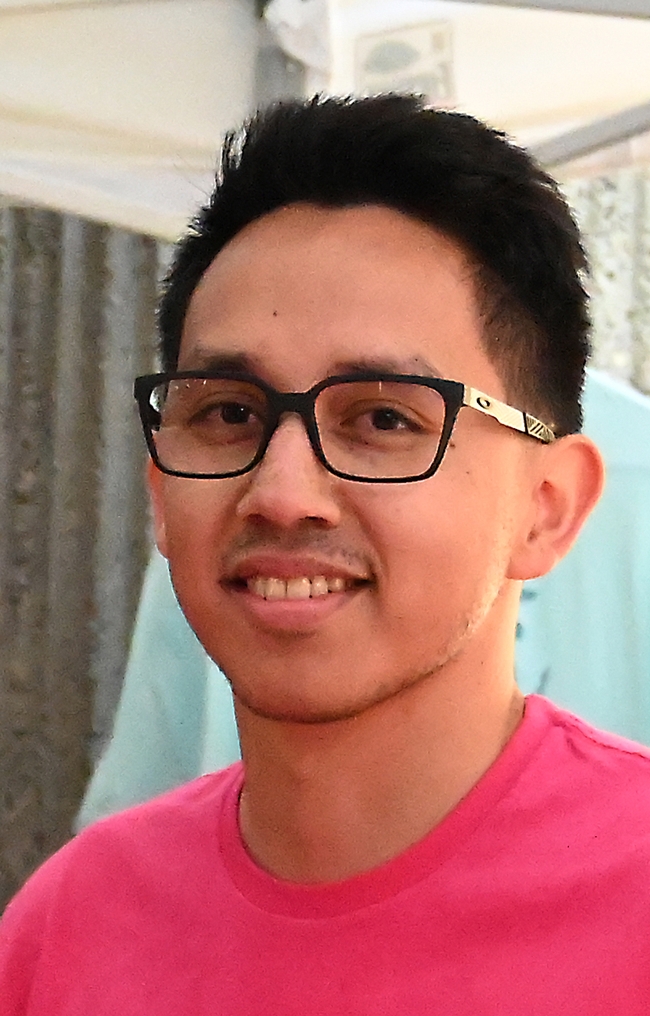
Those are some of the activities planned when the Bohart Museum of Entomology hosts an open house on managed bees and wild bees on Sunday, May 19.
The open house, free and family friendly, takes place from 1 to 4 p.m. in Room 1124 of the Academic Surge Building, 455 Crocker Lane, UC Davis campus.
It's perfect timing for "World Bee Day," observed annually on May 20.
At the Sunday open house, UC Davis graduate student Richard Martinez of the lab of apiculturist Elina Lastro Niño, associate professor of Cooperative Extension, UC Davis Department of Entomology and Nematology, will staff the honey bee booth.
Martinez, enrolled in the master's graduate studies entomology program, says that the E.L, Niño Lab booth will display an observation hive and offer honey tasting from a variety of floral sources. He will be sharing recent projects aimed at improving honey bee health via dietary supplements. He also plans to showcase beekeeping suits and hive tools.
Among others scheduled to participate (as of 4 p.m. today) are:
- the laboratory of community ecologist Rachel Vannette, associate professor and chair of the UC Davis Department of Entomology. She will participate with lab members doctoral candidate Lexie Martin, doctoral student Dino Sbardellati, and junior specialist Leta Landucci. "At the Vannette Lab booth, you will be able to look into the life of a bee--both in terms of where they live and how they develop!" said Martin. "A live bumble bee nest and solitary bee nests will be available, so you can peer inside a bee's house! Additionally, there will be live bee larvae to observe under a microscope and interactive displays on the bee life cycle."
- Bohart Museum bee scientists Thomas Zavortink and Sandy Shanks
- Doctoral student Sofía Meléndez Cartagena of the Stacey Combes lab, Department of Neurobiology, Physiology and Behavior. She will focus on local bee diversity.
- Chancellor's Fellow Santiago Ramirez, associate professor, Department of Evolution and Ecology, who studies orchid bees
- Doctoral student Peter Coggan of the Ramirez lab. He studies the neurological and genetic basis of orchid bee courtship behavior and evolution.
The Bohart Museum houses a global collection of eight million insects, plus a live petting zoo, and a gift shop. Professor Jason Bond directs the museum as of Feb. 1, succeeding Kimsey, who served 34 years. Bond is the Evert and Marion Schlinger Endowed Chair of the Department of Entomology and Nematology, and the associate dean, UC Davis College of Agricultural and Environmental Sciences. He also serves as president-elect of the American Arachnological Society.
For more information, access the website at https://bohart.ucdavis.edu or contact bmuseum@ucdavis.edu.
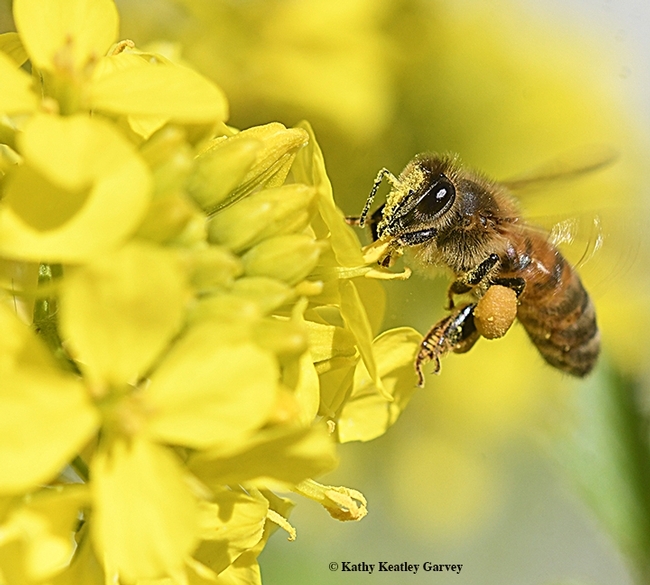
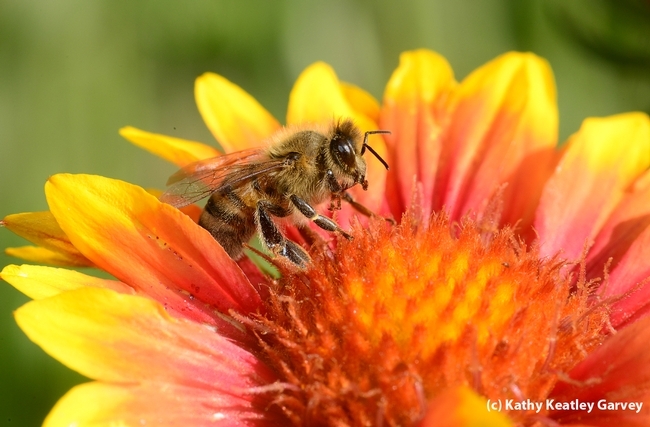
- Author: Kathy Keatley Garvey
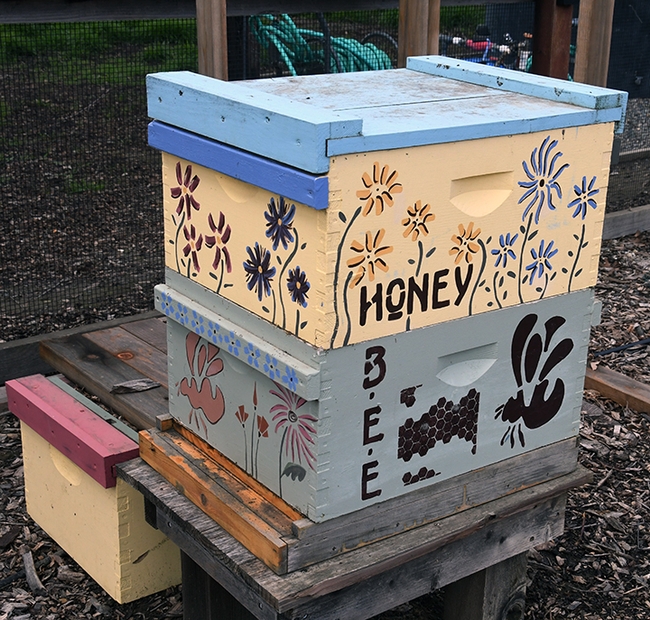
No, wait. Catch...examine...and then release.
That's what attendees will do at the UC Davis Bee Haven's 15th anniversary celebration, set from 10 a.m. to noon on Saturday, April 6 on Bee Biology Road, west of the central campus.
They'll be using a bee vacuum device to scoop up a honey bee, carpenter bee, bumble bee or other pollinator for close observation.
The half-acre garden is located next to the Harry H. Laidlaw Jr. Honey Research Facility. Both are part of the UC Davis Department of Entomology and Nematology.
The open house, free and family friendly, will include a tour of the garden at 11 a.m.; catch-and-release bee activity to observe bees up close; information about low-water plants; and presentations on University of California pollinator research.
The haven is open daily from dawn to dusk (no admission). It is described as "a unique outdoor museum that provides resources for local bee pollinators, inspires and educates visitors to create pollinator habitat gardens, and provides a site for the observation and study of bees and the plants that support them."
Director of the garden is Elina Lastro Niño, associate professor of Cooperative Extension - Apiculture, UC Davis Department of Entomology and Nematology. Christine Casey is the manager, the academic program management officer.
Workers installed the garden in the fall of 2009, under the tenure of interim department chair Lynn Kimsey, now UC Davis distinguished professor emerita, and with primary funds from the Häagen-Dazs ice cream brand. Featuring a series of interconnected gardens with names like “Honeycomb Hideout,” “Nectar Nook” and “Pollinator Patch,” it was designed to provide the Laidlaw honey bees with a year-around food source, raise public awareness about the plight of honey bees, encourage visitors to plant bee-friendly gardens of their own, and serve as a research site.
A six-foot worker bee sculpture of ceramic and mosaic anchors the garden. It's the work of self-described "rock artist" Donna Billick of Davis. UC Davis distinguished professor Diane Ullman and Billick co-founded and directed the UC Davis Art-Science Fusion Program, and their art and that of Ullman's entomology students, as well as members of the community and other volunteers, are showcased throughout the garden.
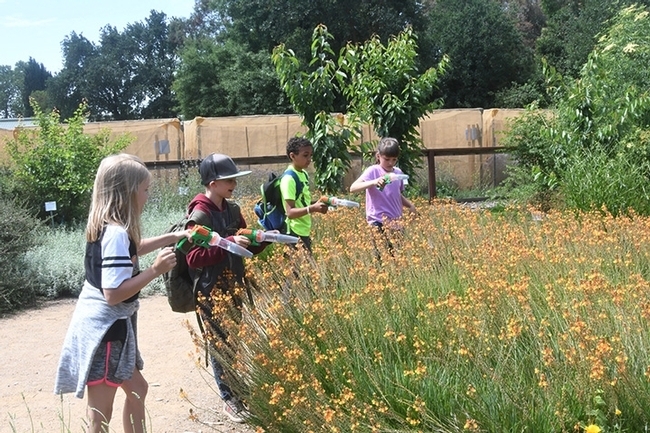
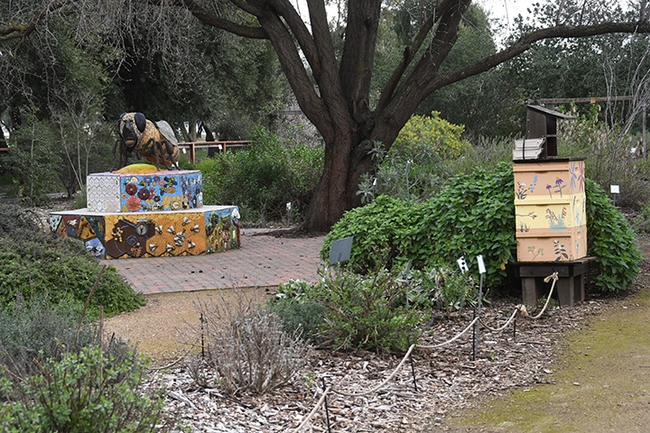
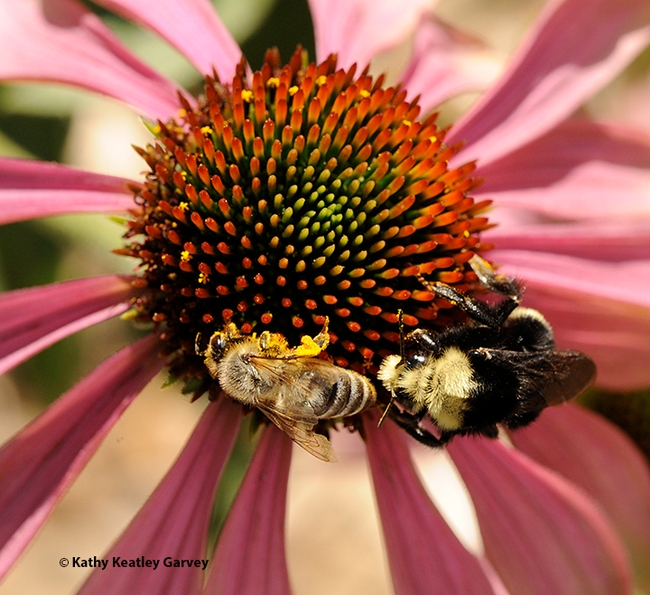
- Author: Kathy Keatley Garvey
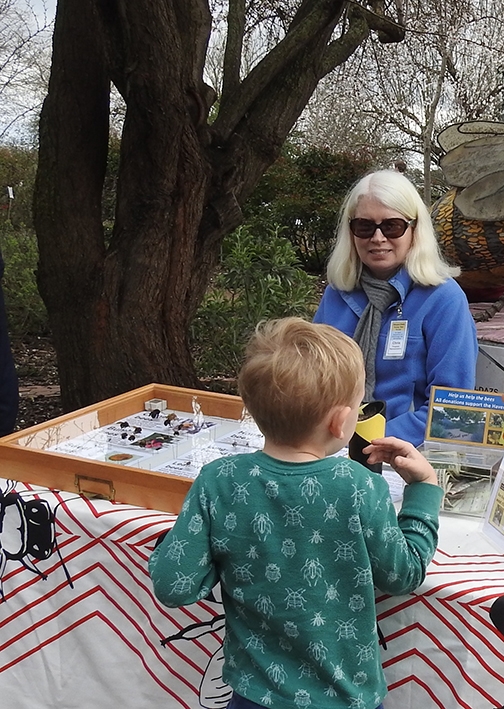
That's when the UC Davis Department of Entomology and Nematology will celebrate the 15th anniversary of its bee garden with an open house from 10 a.m. to noon. It's free and family friendly.
The half-acre garden is located next to the Harry H. Laidlaw Jr. Honey Research Facility on Bee Biology Road, west of the central campus.
The open house will include a tour of the garden at 11 a.m.; catch-and-release bee activity to observe bees up close; information about low-water plants; and presentations on University of California pollinator research.
Open from dawn to dusk (free admission), the Bee Haven is described as "a unique outdoor museum that provides resources for local bee pollinators, inspires and educates visitors to create pollinator habitat gardens, and provides a site for the observation and study of bees and the plants that support them."
Director of the garden is Elina Lastro Niño, associate professor of Cooperative Extension - Apiculture, UC Davis Department of Entomology and Nematology. Christine Casey is the manager, the academic program management officer.
The garden was installed in the fall of 2009, under the tenure of interim department chair Lynn Kimsey, now UC Davis distinguished professor emerita, and with primary funds from the Häagen-Dazs ice cream brand. Featuring a series of interconnected gardens with names like “Honeycomb Hideout,” “Nectar Nook” and “Pollinator Patch,” it was designed to provide the Laidlaw honey bees with a year-around food source, raise public awareness about the plight of honey bees, encourage visitors to plant bee-friendly gardens of their own, and serve as a research site.
“This garden is a living laboratory to educate, inspire and engage people of all ages in the serious work of helping to save honey bees,” said Dori Bailey, then director of Haagen-Dazs Consumer Communications.
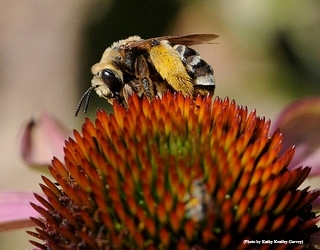
Art graces the garden, thanks to the UC Davis Art/Science Fusion Program, founded and directed by entomologist-artist Diane Ullman, UC Davis distinguished professor of entomology; and Davis-based artist Donna Billick. Billick, a self-described "rock artist," sculpted the six-foot-long worker bee that anchors the haven. Students and area residents crafted the bee-motif ceramic tiles that line a bench, which also includes the names of major donors.
A mural featuring native bees graces the shed in the garden. It was a project of the Entomology 1 class, "Art, Science and the World of Insects," taught by Ullman and Billick. Then doctoral student Sarah Dalrymple of the Rick Karban lab, served as the graphics project coordinator and teaching assistant, guiding the students on design, creation and installation of the panels. She went on to be named the 2011 recipient of the UC Davis Outstanding Graduate Student Teaching Award and praised for fusing the boundaries of biology, art and culture.
The Bee Haven came to "bee" after officials at the Haagen-Dazs read a research news story on honey bees, written by communication specialist Kathy Keatley Garvey and telephoned her. The article, on "building a better bee," chronicled the plight of honey bees and the work of bee breeder-geneticist Susan Cobey, then manager of the Harry H. Laidlaw Jr. Honey Bee Research Facility and now with Washington State University. Haagen-Dazs served as the primary donor of the garden and also funded the Häagen-Dazs Postdoctoral Fellowship at UC Davis. It went to Michelle Flenniken, an insect virus researcher based at UC San Francisco. She is now a professor at Montana State University.
Links:
Sausalito Team Wins Design Competition
http://ucanr.edu/blogs/blogcore/postdetail.cfm?postnum=15240
Grand Opening Celebration of Honey Bee Garden
http://ucanr.edu/blogs/blogcore/postdetail.cfm?postnum=15249
Eagle Scout Project: Fence Around the Bee Garden
http://ucanr.edu/blogs/blogcore/postdetail.cfm?postnum=10166
Campus Buzzway: Wildflowers
http://ucanr.edu/blogs/blogcore/postdetail.cfm?postnum=15242
Haagen-Dazs Honey Bee Haven: Sacramento Bee Award
(With photo of founding volunteers)
http://ucanr.edu/blogs/blogcore/postdetail.cfm?postnum=10205
Shedding Light on Native Bees
https://ucanr.edu/blogs/blogcore/postdetail.cfm?postnum=27570
For more information on the UC Davis Bee Haven, access the website at https://beegarden.ucdavis.edu.
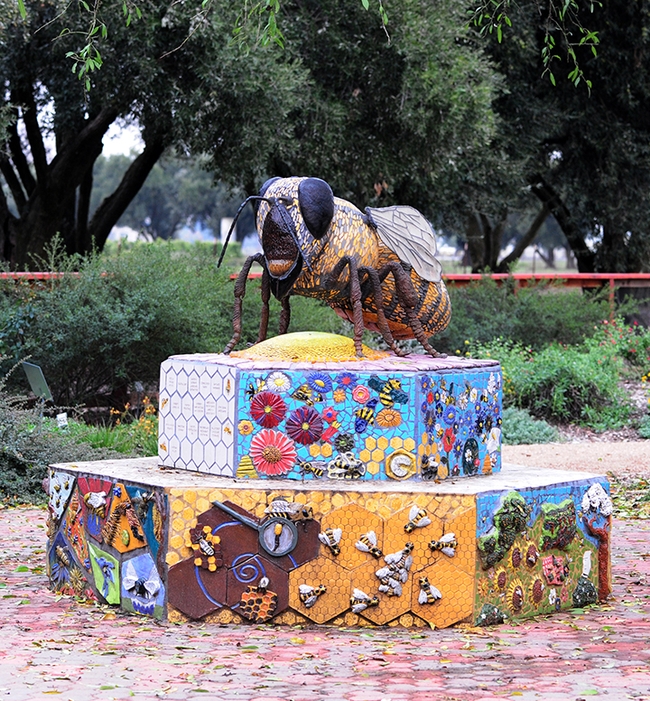
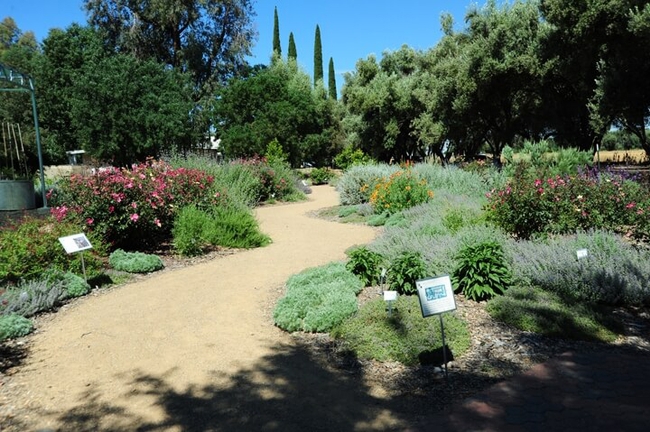
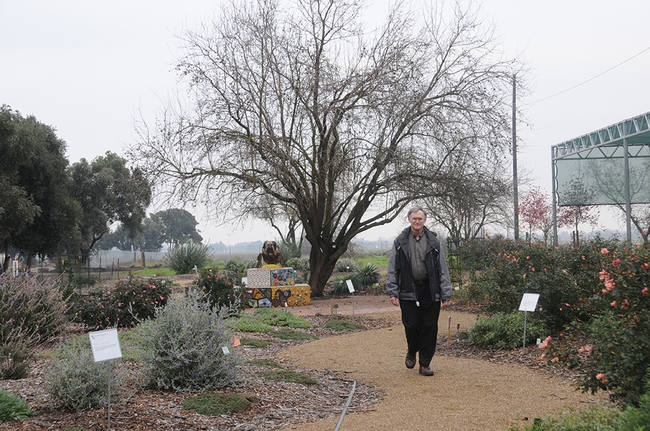
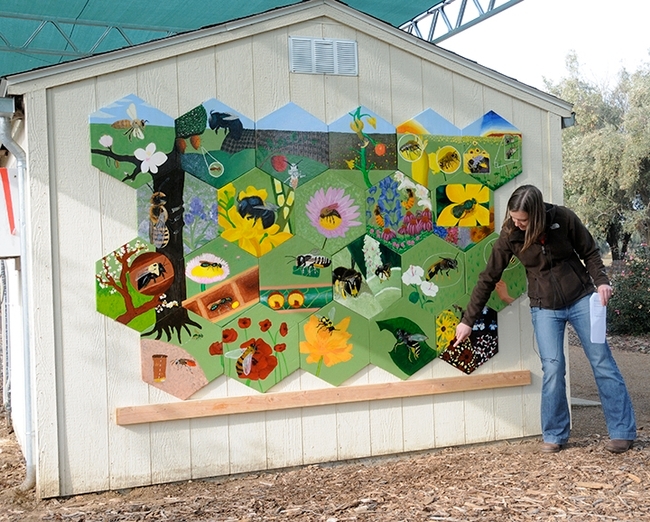
- Author: Kathy Keatley Garvey
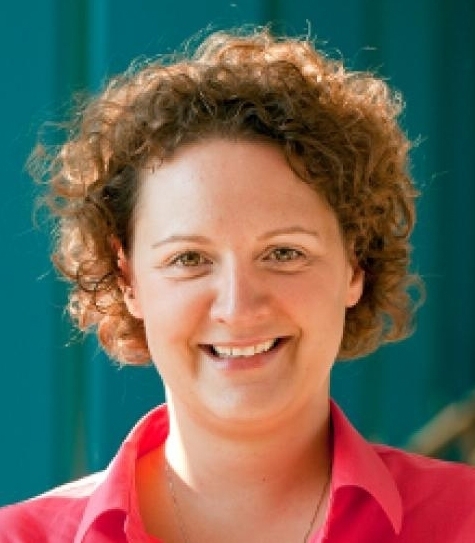
The six-member team, including Elina Lastro Niño, associate professor of UC Cooperative Extension, UC Davis Department of Entomology and Nematology, is sharing an online pre-print version of their research on the yield characteristics of a self-compatible almond variety.
The paper, titled “Comparison of Yield Characteristics of Independence, a Self-Compatible Almond Variety, as Affected by the Presence of Honey Bee Pollinators,” is online at https://www.researchsquare.com/article/rs-3870916/v1 during the review process for Scientific Reports.
Co-authors with Niño are Angelita De la Luz, Beeflow Inc. Smart Pollination Services; Bernardo Niño, Xerces Society for Invertebrate Conservation (he is formerly from UC Davis); William Stacy, UC Davis Extension; and Arathi Seshadri, U.S. Department of Agriculture's Agricultural Research Service (USDA-ARS).
The abstract:
“Until recently, all the almond varieties grown globally, have been self-incompatible, a fact that drives the interdependent relationship between almond growers and the beekeepers that provide honey bee colonies for pollination. Recently, almond growers have begun a transition to self-fertile varieties, such as Independence, which do not require genetically distinct pollen to produce kernels. However, this transition often occurs under the impression that due to self-compatibility, one can eliminate the honey bee rentals for pollination and thereby reduce costs for these orchards, but the impact that eliminating rented colonies would have on almond quality and yield are not fully understood.”
“Here, we explore the extent to which yields for Independence variety vary with and without honey bee pollination and across a range of hive stocking densities in the San Joaquin Valley of California. We found that access to honey bee pollination significantly improves nut set and whole tree yields, ultimately resulting in economically meaningful gains to growers. Our economic model shows how specific honey bee hive stocking density recommendations depend on the surrounding landscape and will change as acreage of self-fertile varieties continues to increase over time."
In their research, the authors point out that
- The United States is the world's largest almond producer, with California accounting for nearly 80 percent of the world's almond supply
- Almond orchards rank as the highest in their need for pollinators, specifically honey bees
- California's almond orchards need more than a million honey bee colonies every season for pollination, brought in all over the country and globally
- There are insufficient colony numbers stemming from poor nutrition, improper use of agrochemicals, loss of natural habitat and increased incidences of pests and diseases,
- Until recently, all the almond varieties grown in California have been self-incompatible and almond growers depend exclusively on beekeepers to provide honey bee colonies for pollination
"For growers and beekeepers alike, the question at the forefront is to determine the extent to which self-fertile varieties such as Independence, reduce the dependency on pollination services rendered by managed honey bees," the authors wrote. "Growers specifically, are also interested in knowing any differences in yield quality and quantity resulting from absence of bee-pollination-mediated pollen transfer and ovule fertilization, given that previous studies have reported higher oleic to linoleic ratio in almonds from cross-pollinated trees and this high ratio is most favorable for consumers seeking health benefits."
See more at https://www.researchsquare.com/article/rs-3870916/v1
(Note: Research Square lets researchers share their work early, gain feedback from the community, and start making changes to their manuscript prior to peer review in a journal. Contact Elina Lastro Niño at elnino@ucdavis.edu)
